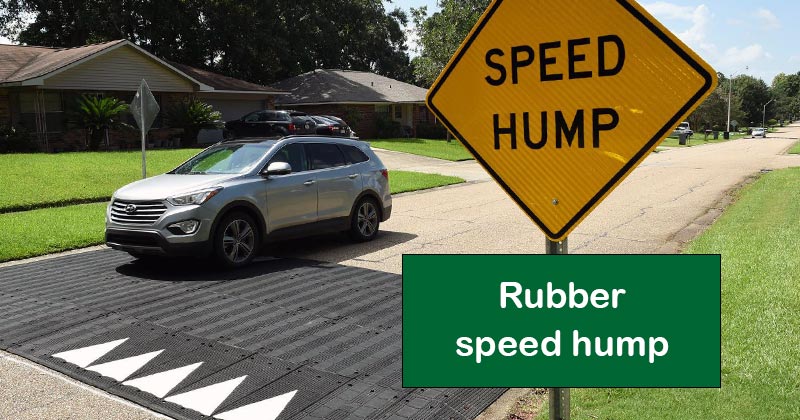Speed bumps and speed humps are undoubtedly a source of annoyance for many drivers. You have to slow down or risk damaging your vehicle. That begs the question, “Do speed bumps work?”
Research shows that speed bumps are effective at reducing traffic accidents and deaths. The odds of a child pedestrian being injured are more than halved after speed humps are installed.
Of course, this is not the final word on whether it’s a good idea to install a speed bump in any given case. You have to factor in the risks without speed bumps plus the costs. A further consideration is that traffic may be diverted elsewhere.
Here’s my experience of speed bumps being proposed for my neighborhood and why I changed my mind.
Speed Bump vs Speed Hump
- A speed bump is narrower (shorter to drive over) than a speed hump.
- A speed bump is often elevated (taller), causing a more severe tire impact.
- Dimensions of speed bump: 1-3 feet to drive over, 4-6 inches high.
- Dimensions of speed hump: 10-12 feet to drive over, 3-4 inches high.
- Common driving speed for speed bump: 5-10 miles per hour
- Common driving speed for speed hump: 20 miles per hour
Speed Humps and Bumps Feel Like a Nuisance
Like most suburban Washington, DC neighborhoods, ours is off a small street that has become shortcut for commuters looking to avoid a congested intersection. Most drivers fly down the street well above the speed limit. In this area, everybody’s neighborhood is somebody’s super secret traffic hack (DC traffic is the worst, well… almost).
Last summer we received a letter in the mail notifying us that the city was giving us options to help reduce speeding. Our options, put to an informal mail-in vote were:
- Speed bumps or
- Pay for additional police enforcement.
My husband and I groaned at the option of speed bumps. Anyone who has ever had a sleeping infant or toddler in a car knows that a speed bump is a sleeping baby landmine.
We both supported paying for increased police enforcement. Besides, we reasoned, speed bumps don’t slow people down, people just speed up between them, right?
Speed Humps Lower Accidents and Deaths

Being a data nerd, before we voted I dug into the peer-reviewed research and it turns out we were absolutely wrong. Children’s lives are potentially saved by speed humps and bumps. In neighborhoods where children play on the street, safety improves.
Speed humps were associated with a 53% to 60% reduction in the odds of injury or death among children struck by an automobile in their neighborhood.
Tester et al – American Journal of Public Health
Speed bumps were far more effective in reducing risk than increased police enforcement. And I discovered that decades of study across the world showed: not only do speed bumps slow drivers down, they reduce both car accidents and pedestrian deaths. So we changed our vote, and the speed bumps were added a few months ago.
Pros and Cons of Speed Bumps

The decision to install a speed hump or bump is always case dependent. You need to weigh up the pros and cons.
Traffic speed controllers, which also include speed tables and rumble strips, largely solve the problem of cars speeding through residential areas. That provides safety and other benefits. But there are significant costs, the key one being an overall worse driving experience.
Advantages
The biggest potential advantages relate to safety. Automobile accidents are less likely, especially fatal accidents involving pedestrian children. You also have the ability to divert traffic away from roads not intended for mass commuting.
- An effective traffic-calming tool. Speed humps are widely used on suburban roads to slow down cars and other vehicles and ensure drivers are paying attention. Speed humps slow most vehicles down to 25 miles per hour (mph) or less, often well below local speed limits. Speed bumps are even more effective at reducing speeds and are especially good at preventing parking lot accidents.
- Saves lives of pedestrians, especially children. Well-placed speed humps and bumps of the appropriate design reduce accident risks dramatically. With lower traffic speeds, the risks of accidents are reduced as well as the severity when they happen.
- Diverts traffic away from school zones and other sensitive areas. Installing speed humps deters drivers from rat running through residential areas where safety and noise issues are more problematic.
Disadvantages
The disadvantages are also significant. While speed humps are a relatively inexpensive way to slow traffic down, and don’t require monitoring, they make travel harder. Drivers need to do more work and their commute times increase. Vehicle damage is also an issue, especially for drivers who fail to slow down sufficiently.
- Increases driving times and fuel costs. Speed humps and bumps force drivers to do more slowing down and speeding up, effectively increasing journey length. Drivers lose time in slowing down from the speed limit to a safe speed for the traffic calming device. They use extra fuel in then accelerating back up to near the speed limit.
- Lowers the quality of the driving experience. Drivers have to do more work to navigate through roads where speed humps are installed. They also experience a jolt when travelling over these obstacles. A potentially simple drive down a road is made relatively unpleasant and demands more focus and energy.
- Increases vehicle wear and tear. Vehicles may be damaged by either (a) repeated travel over speed humps at above safe speeds or (b) failing to notice a speed hump and slamming into it at high speed. Areas of potential damage include: shock absorbers, power steering, wheel alignment, exhaust system and tires (Source: Sun Auto Service).
- Slows down emergency vehicles. Response times for emergency vehicles, which are often large vehicles, drop as they navigate traffic calming devices.
Each hump costs fire trucks ten seconds in response time … The humps keep drivers from going more than 25 miles an hour.
wftv.com
Be Open to Changing Your Mind

But the issue isn’t just about a speed bump or traffic. It’s also about being unafraid to be wrong and changing your mind with new information, even if it’s inconvenient.
Our generation of parents has been trained to view actions as synonymous with character. If a parent makes a less-than-ideal decision (or hell, a benign decision that we wouldn’t make) we’ve been trained to believe they must be a bad parent.
My husband and I weren’t bad parents because we initially thought speed bumps wouldn’t reduce the traffic problem. We were just wrong about that issue. When we had better information we changed our opinion.
So why do many of us persist in our current beliefs even when we’re confronted with evidence hat those beliefs are incorrect? Our brains don’t help matters. In fact the brain is hard wired to reassure us that we’re right, even when we’re wrong.
Even the smartest among us are guilty of persisting in beliefs even when confronted with contradictory information. The ways in which we convince ourselves that we’re right when we’re actually wrong are called confirmation biases, and there are a few different types.
We’re Motivated to Believe Speed Bumps Aren’t Worth It

I wanted to escape the confirmation bias trap with the speed bump issue and do what was truly safest for our toddler. Incidentally, our little one wasn’t always consistent when told that the street wasn’t for playing. I did what I usually do in these situations: Try to prove myself wrong.
The first thing I did was to voice my opinion to others who I didn’t think would necessarily agree with me. This was an example of avoiding the confirmation bias known as the echo chamber. We tend to seek information from sources we think are likely to agree with us.
While chatting with neighbors, I mentioned that we were thinking of voting for increased enforcement. My neighbor replied that he’d been at a meeting with a city planner who explained that speed bumps were much more effective at reducing pedestrian deaths.
I was a little sceptical of what the city planner had apparently said. “Of course he’d say that,” I thought, “increased enforcement probably costs the county a ton in police overtime and he’s looking to save money.”
My dismissal of the city planner’s statement is an example of a phenomenon called motivated reasoning, first identified in the 1950s. Motivated reasoning is often subconscious, meaning that we don’t do it on purpose. In this process we often discard, or put less emphasis on evidence that contradicts our current point of view, and include or put heavy emphasis on evidence that supports it.
Motivated reasoning happens in a few ways, including only looking for information that we know supports our beliefs. For example, my neighbor’s statement was enough to make me investigate how wrong I may actually be. So I turned to the peer-reviewed literature, but I knew I had to search smartly if I wanted to get an accurate answer.
Research Shows Speed Bumps Improve Safety
Had I been looking simply to confirm my hypothesis, I could have searched for “speed bumps” ineffective traffic deaths, in JStor. In this case, the results focus on citizen’s individual freedom and less on the statistical data. Instead I searched for traffic deaths “speed bumps”. I specifically kept the search terms neutral because I wanted to know what the data actually said and the resulting studies showed me that I was wrong.
When I brought the evidence to my husband and told him we were going to be changing our vote, he groaned and protested. I gave him a little while to think it over. He eventually came around acknowledging that the improvements in safety outweighed the inconvenience of the speed bumps. Not that he had any say in it, I’d already changed our vote and mailed in our ballot.
